Compiled by Tom Lake, Hudson River Estuary Program Consulting Naturalist
Overview
We included two rarities this week, neither quite in the watershed, but both deserving mention. Air temperatures were on a roller coaster: one day record cold, a couple of days later record warmth. On the river, heavy ice was making marauding bald eagles very happy.
Highlight of the Week
2/4 – Glens Falls, HRM 208: Two days after record-tying cold, today’s air temperature reached 54 degrees Fahrenheit (F), tying the record high for the date. Across a two-day period, the maximum high and maximum low temperatures varied by 72 degrees F.
- National Weather Service
Natural History Entries
2/2 – Glens Falls, HRM 208: This was the sixth straight day of below-zero air temperatures, culminating in a reading of -18 degrees F, one-degree shy of the record for the date.
- National Weather Service
 2/2 – New Paltz, HRM 78: I have had two banded house finches (Carpodacus mexicanus) at my feeders recently, one male and one female. I would love to know where the house finches came from, who banded them, and why. Two days ago, a very pretty male (leucistic) house finch also showed up at the feeders. (Photo of house finch courtesy of Pam Plummer) 2/2 – New Paltz, HRM 78: I have had two banded house finches (Carpodacus mexicanus) at my feeders recently, one male and one female. I would love to know where the house finches came from, who banded them, and why. Two days ago, a very pretty male (leucistic) house finch also showed up at the feeders. (Photo of house finch courtesy of Pam Plummer)
- Pam Plummer
[Pam Plummer’s banded house finches are ours (Kara Belinsky): My SUNY New Paltz Research in Biology class. We have banded several hundred house finches, goldfinches, and chickadees over the past two summers (2017, 2018). All the birds have a USGS numbered band as well as three color bands (some are striped).
● The male house finch with a dark green-over-silver and black-over-yellow band, was banded by my student (Callie) and me on 6/20/2018 at one of our forest edge sites at the South Edge of campus).
● The female house finch with a dark green-over-silver and yellow-over-pink, was banded by my student (Kristyn) and me on 6/5/2018 at the same forest edge site (at the South Edge of campus).
Our research question is two-fold: We would like to know more about their seasonal movements, and we’re “asking” the birds to tell us what types of landscaping/buildings/development best supports birds, e.g., which of our nine campus bird feeders do they visit and stay at most often? Which residential neighborhoods and yards do the same? How can we design campuses and suburbs to better support birds? If we were able to follow individual birds through time, they could tell us this on a larger scale.
If you have a sighting of a banded bird, please contact us so we can add to our database: (NPcolorbandedbirds@gmail.com or Instagram @newpaltzornithology). Kara Belinsky]
 2/2 – Town of Poughkeepsie: The adult eagle pair from bald eagle nest NY62 were out on the ice today, fighting for space and jousting with a third adult, probably a wintering bird. While the winter river is sometimes iced-over or choked with ice floes, eagles always seem to find a way to get their fish. (Photo of bald eagles on the ice courtesy of John Badura) 2/2 – Town of Poughkeepsie: The adult eagle pair from bald eagle nest NY62 were out on the ice today, fighting for space and jousting with a third adult, probably a wintering bird. While the winter river is sometimes iced-over or choked with ice floes, eagles always seem to find a way to get their fish. (Photo of bald eagles on the ice courtesy of John Badura)
- John Badura
2/2 – Verplanck, HRM 40.5: It was almost sunset at Verplanck’s waterfront, as the sun was hidden behind a beautiful purple and orange sky. At first, we noticed just one bald eagle flying high over Stony Point across the way, but upon closer observation, we counted 12 eagles perched on a long strip of ice on the edge of the channel. Initially three double-crested cormorants were on the channel marker, but soon nine more circled the marker and joined them.
- Dorothy Ferguson, Bob Ferguson
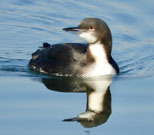 2/2 – Long Island Sound: We spotted a Pacific loon in winter plumage in western Long Island Sound at Oyster Bay not far from the East River. It was in company with a red-necked grebe and a raft of 45 long-tailed ducks. (Photo of a Pacific loon courtesy of John Gaglione) 2/2 – Long Island Sound: We spotted a Pacific loon in winter plumage in western Long Island Sound at Oyster Bay not far from the East River. It was in company with a red-necked grebe and a raft of 45 long-tailed ducks. (Photo of a Pacific loon courtesy of John Gaglione)
- John Gaglione
[Pacific loon (Gavia pacifica) breed in the Canadian Arctic and winter along the West Coast south into Mexico. They are considered an accidental visitor (stray) to the Northeast. From 2000-2019, there have been a few dozen records from Maine to Cape May, NJ, but only about one dozen from coastal New York State. Western Long Island Sound is a natural extension of the watershed via the Harlem and East rivers. Tom Lake]
2/3 – Washington County, HRM 209: It was a raptor bonanza today at the Washington County Grasslands. The five species included nine rough-legged hawks, two of which were dark phase, one male (“gray ghost”) northern harrier, a sharp-shinned hawk, five red-tailed hawks, and two barred owls.
- Scott Varney (Hudson-Mohawk Bird Club)
2/3 – Gansevoort, HRM 197: We had a nice mixed flock of approximately 40-50 each of horned larks and snow buntings this afternoon on Rugg Road. We did not find any Lapland longspurs.
- Gregg Recer, Cathy Graichen (Hudson-Mohawk Bird Club)
2/3 – Town of Fishkill, HRM 63: I watched a flock of a dozen male and female cardinals in my
backyard in early morning. Then I heard that lovely first spring song being sung between
two of them: “Birdie, birdie, birdie.”
- Andra Sramek
2/3 – Town of Fishkill, HRM 63: In midday, walking on the road between the manor house and the barn at the Stony Kill Environmental Center, I watched a flock of 25 rose-breasted grosbeaks landing in the cow field, then onto the macadam road, then back to the field. They seemed happy with the warmer, sunny weather (47 degrees F).
- Andra Sramek
2/4 – Wappinger Falls, HRM 67.5: The air temperature reached 61 degrees F today, one-degree shy of the record high for the date.
- National Weather Service
2/4 – Palisades, HRM 23: Red-winged blackbirds were calling this morning from the marsh at Lamont-Doherty Earth Observatory. This was at least two weeks earlier than what we think is usual.
- Linda Pistolesi
2/5 – Rensselaer County, HRM 168: We saw our first-of-season turkey vulture this afternoon teeter-tottering in the sky above Staats Island Road in East Hoosick. We also estimated more than 1,000 blackbirds (varied sizes and varied tail lengths) converging on the reedy marshes. Early red-winged blackbirds?
- Rita Reed (Hudson-Mohawk Bird Club)
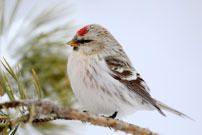 2/5 – Coxsackie, HRM 118: We found an estimated 50 common redpolls in a field north of Coxsackie. At least one Hoary Redpoll (Acanthis hornemanni) was in with the common redpoll flock. (Photo of Hoary Redpoll courtesy of Douglas Faulder) 2/5 – Coxsackie, HRM 118: We found an estimated 50 common redpolls in a field north of Coxsackie. At least one Hoary Redpoll (Acanthis hornemanni) was in with the common redpoll flock. (Photo of Hoary Redpoll courtesy of Douglas Faulder)
- Zach Schwartz-Weinstein (Hudson-Mohawk Bird Club)
[Common redpolls and hoary redpolls can be nearly indistinguishable from one another. In fact, because they can breed with one another, there is debate among ornithologists, naturalists, biologists, and birders as to whether they are really separate species or just variations of the same bird. Both of these finches prefer northern regions, but the common redpoll is the more southerly of the two and is much more likely to appear further south during irruptions. Hoary redpolls stay further north, and while they may also irrupt to the south, those appearances are far rarer. Audubon.com]
2/5 – Town of Poughkeepsie: As has been the case in recent days, the adult pair of bald eagles at nest NY62 were in full mating mode with several brief copulating episodes. They were still about three weeks from an anticipated egg-laying. The female flew to the nest today with talons-full of downy nesting material. As she approached the tall tulip tree, gliding on flat wings, they looked like a pair of ironing boards!
- Bob Rightmyer
2/5 – Town of Poughkeepsie, HRM 75: The air temperature reached 61 degrees F today, one-degree shy of tying the record high for the date.
- National Weather Service
2/5 – Newark, NJ: The air temperature reached 68 degrees F today, one-degree shy of the record high for the date.
- National Weather Service
*** Fish of the Week ***
With winter here and much of the watershed’s ponds, creeks, lakes, and rivers iced-over, some of us are going through fish withdrawal. As a coping device, until fully open water returns in March, we will have a “Fish of the Week” feature.
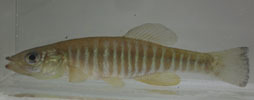 2/6 – Hudson Valley Estuary: This week’s fish is the banded killifish (Fundulus diaphanus diaphanus), a native species and number 115 (of 228) on our watershed list of fishes. Banded killifish are one of five members of the killifish family (Cyprinodontidae) in the watershed, including one that is a favorite with most students, the mummichog. They are not large – most are index-finger-size, slender with a bit of a snout – and are marvels of adaptation. They can be found from the high salinity waters of the lower estuary to the full freshwater of the river above tidewater. Because insect larvae are a significant component of the killifish diet, killifish have been used as a biological control for mosquitoes. Traveling in large schools, they are a favorite of many predatory fishes from pickerel to pike and striped bass to bluefish. Iconic riverman Everett Nack called them “blue-banded mudminnows,” owing to the breeding male’s incredibly beautiful lavender bands. (Photo of banded killifish courtesy Tom Lake) 2/6 – Hudson Valley Estuary: This week’s fish is the banded killifish (Fundulus diaphanus diaphanus), a native species and number 115 (of 228) on our watershed list of fishes. Banded killifish are one of five members of the killifish family (Cyprinodontidae) in the watershed, including one that is a favorite with most students, the mummichog. They are not large – most are index-finger-size, slender with a bit of a snout – and are marvels of adaptation. They can be found from the high salinity waters of the lower estuary to the full freshwater of the river above tidewater. Because insect larvae are a significant component of the killifish diet, killifish have been used as a biological control for mosquitoes. Traveling in large schools, they are a favorite of many predatory fishes from pickerel to pike and striped bass to bluefish. Iconic riverman Everett Nack called them “blue-banded mudminnows,” owing to the breeding male’s incredibly beautiful lavender bands. (Photo of banded killifish courtesy Tom Lake)
If you would like a copy of our watershed fish list, e-mail: trlake7@aol.com.
- Tom Lake
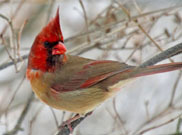 2/6 – Manhattan, HRM 13.5: It was just a couple of days after the cold spell, and I found signs of spring at Inwood Park. Tiny shoots of Star-of-Bethlehem had appeared, and in the Clove, shoots of snowdrops were three-inches-high. I counted thirty Canada geese on the upper ball fields. 2/6 – Manhattan, HRM 13.5: It was just a couple of days after the cold spell, and I found signs of spring at Inwood Park. Tiny shoots of Star-of-Bethlehem had appeared, and in the Clove, shoots of snowdrops were three-inches-high. I counted thirty Canada geese on the upper ball fields.
I also glimpsed a cardinal that looked different. I remembered a recent article in The New York Times (2/2) about a bilateral gynandromorph northern cardinal in Erie, PA, about 400 miles northwest of New York City. Now, I wonder if that was what I saw. The bird was a cardinal with the distinct crest, but the head was bright red and the body mostly buff or yellowish. I am mentioning this different-looking cardinal on the chance that another birder might spot it. (Photo of northern cardinal courtesy of Shirley Caldwell)
- Thomas Shoesmith
[This Pennsylvania cardinal is another instance where something fascinating occurs beyond our watershed (see the Oyster Bay Pacific loon). However, considering that birds can fly, perhaps this can be a preemptive entry worthy of stretching our “borders.” Tom Lake]
2/7 – Mechanicville, HRM 168: Driving by in midday, I saw that were waterfowl in the open water on the Hudson River at Lock 2 of the Hudson-Champlain canal. The expected birds were there, Canada geese and common mergansers, and I was pleased to see a pair of northern pintails near the edge of the ice. They are such cool ducks (I know, I say that about all the ducks!).
- Ron Harrower
2/7 – Troy, HRM 153: I heard a Carolina wren singing in my yard this morning, a song of spring-to-come from this former southern songbird.
- Heidi Klinowski (Hudson-Mohawk Bird Club)
[On January 6, during the Esopus Bend Nature Preserve Winter Bird Count, Steve Chorvas counted 22 Carolina wrens (Thryothorus ludovicianus), a number well-above the annual count’s average of 12.5. Tom Lake]
2/7 –Selkirk, HRM 135: I visited Henry Hudson Park in the Town of Bethlehem to check on my weekly river activity. I found two adult bald eagles in the nest (NY81) across the river. I am so happy to be able to follow them once again this year. The last time I visited the park six days ago, the river was frozen bank-to-bank, and the bald eagle nest was full of snow. It made me wonder (worry) if the nest was abandoned.
- Roberta Jeracka
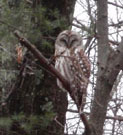 2/7 – Ulster County, HRM 78: While walking along Lenape Lane on the Mohonk foothills this afternoon, I had six white-tailed deer rapidly dash across the trail directly in front of me. This small group was comprised of four does and two six-point bucks (both had full antler sets not having shed yet). While this unexpected event sent my heart racing, my encounter with a barred owl was even more enjoyable. I spotted the owl within fifty feet of the trail edge. It was perched twenty feet off the ground glancing down at me seemingly undisturbed by my presence. I sat on a nearby rock watching for twenty minutes, then left before the owl got tired of looking at me. (Photo of barred owl courtesy of Bob Ottens) 2/7 – Ulster County, HRM 78: While walking along Lenape Lane on the Mohonk foothills this afternoon, I had six white-tailed deer rapidly dash across the trail directly in front of me. This small group was comprised of four does and two six-point bucks (both had full antler sets not having shed yet). While this unexpected event sent my heart racing, my encounter with a barred owl was even more enjoyable. I spotted the owl within fifty feet of the trail edge. It was perched twenty feet off the ground glancing down at me seemingly undisturbed by my presence. I sat on a nearby rock watching for twenty minutes, then left before the owl got tired of looking at me. (Photo of barred owl courtesy of Bob Ottens)
- Bob Ottens
2/7 – Orange County, HRM 41: I conducted my annual winter raptor survey of the Black Dirt region and Wallkill National Wildlife Refuge. I tallied 80 raptors of ten species headlined by ten widely scattered rough-legged hawks. The three merlins I counted were more than expected. Red-tailed hawk numbers were good, and there was an immature drinking from a puddle on Onion Avenue.
- Steve Walter
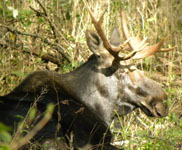 2/8 – Adirondack Mountains: In its fifth straight year of aerial surveying for moose in the Adirondack State Park, the NYS Department of Environmental Conservation (DEC) reported spotting nearly 100 healthy moose over a four-day period. In 42 hours of helicopter flight time, 83 moose or groups of moose, all of which appeared healthy, were observed. Data from these surveys will refine our estimate of the moose population in the Adirondacks and will help inform a future moose management plan. The annual survey is part of a collaboration between DEC, Cornell University, the SUNY College of Environmental Science and Forestry, the Biodiversity Research Institute, and the Wildlife Conservation Society. 2/8 – Adirondack Mountains: In its fifth straight year of aerial surveying for moose in the Adirondack State Park, the NYS Department of Environmental Conservation (DEC) reported spotting nearly 100 healthy moose over a four-day period. In 42 hours of helicopter flight time, 83 moose or groups of moose, all of which appeared healthy, were observed. Data from these surveys will refine our estimate of the moose population in the Adirondacks and will help inform a future moose management plan. The annual survey is part of a collaboration between DEC, Cornell University, the SUNY College of Environmental Science and Forestry, the Biodiversity Research Institute, and the Wildlife Conservation Society.
DEC and its moose partners have a website with an online form to log moose sightings. For more information on moose in New York, including the sighting form, see: https://www.dec.ny.gov/animals/6964.html. (Photo of moose courtesy of Tom Lake)
- Justin Levine
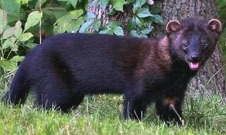 2/8 – Minerva, HRM 284: It seemed like wildlife week up here! At 6:00 PM this evening, while driving up Route 30 from Lake Pleasant to Indian Lake, a fisher ran across the road in front of me about a mile north of the trailhead for Snowy Mountain in the Town of Indian Lake. I think it was only the second live fisher I've ever seen up here (most of the others were road-killed). (Photo of fisher courtesy of Madline Dennis) 2/8 – Minerva, HRM 284: It seemed like wildlife week up here! At 6:00 PM this evening, while driving up Route 30 from Lake Pleasant to Indian Lake, a fisher ran across the road in front of me about a mile north of the trailhead for Snowy Mountain in the Town of Indian Lake. I think it was only the second live fisher I've ever seen up here (most of the others were road-killed). (Photo of fisher courtesy of Madline Dennis)
- Mike Corey
[Fishers (Martes pennanti) are one of our largest weasels (our river otters are similar-sized) reaching over forty-inches in length. They are seen periodically in the Catskills and Adirondacks and are not rare in the Mid-Hudson Valley. While the name of this fur bearer suggests an aquatic habitat and diet, they actually much prefer dense forests and porcupines. One of the colloquial names for fisher is “fisher-cat.”
Fishers are native to New York State and a member of the Mustelidae family (mustela,is Latin for weasel) along with other New York State mammals such as mink, American marten, and various other smaller weasels. Ellen Rathbone]
2/8 – Town of Poughkeepsie, HRM 75: The air temperature reached 55 degrees F today, one-degree shy of the record high for the date.
- National Weather Service
2/8 – Manhattan, HRM 1: We faithfully checked our research sampling gear twice this week in Hudson River Park at The River Project's sampling station on the lighthouse tender Lilac at Pier 25. It was unseasonably warm on both days. On 2/5, the air temperature was 65 degrees F, and today it was 55. We are still waiting patiently for our first fish of 2019. On both days this week our killifish traps caught an assortment of shore shrimp, isopods, and mud crabs.
- Siddhartha Hayes, Toland Kister
[The anticipation of The River Project’s “first fish” of the year is increasing. It had me thinking of a line, or a variation of a line, from the movie Field (River) of Dreams: The fish (sic) are there. If you set the gear, they will come! Tom Lake]
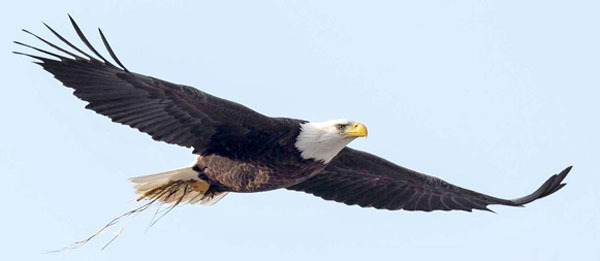 Winter 2019 Natural History Programs Winter 2019 Natural History Programs
Volunteer Opportunity: Hudson River Eel Project
We are seeking volunteers to help study eels in streams of the Hudson River estuary! Volunteers check specialized nets for young transparent "glass eels" as they enter freshwater from their spawning grounds over 1,000 miles away in the Atlantic Ocean. Eels are counted, weighed, and released upstream, and environmental conditions are recorded. Sample sites include streams from NYC to Troy, and all gear is provided. See: https://www.dec.ny.gov/lands/49580.html
For more information, e-mail Aidan Mabey: aidan.mabey@dec.ny.gov
Hudson River: Striped Bass Cooperative Angler Program
You can share your fishing trip information and help biologists understand and manage our Hudson River striped bass fishery.
Here’s how it works: Fill out a logbook provided by us whenever you fish on the Hudson River (by boat or from shore). Record general location, time, gear used, what you caught (or if you didn’t catch anything) and return the logbook when you are done fishing for the season. You’ll receive an annual newsletter summarizing the information in addition to the latest news regarding regulations and the river. Whether you catch-and-release or take home a keeper, you can be part of the Cooperative Angler Program.
Join today by contacting: jessica.best@dec.ny.gov, or call 845-256-3009.
- Jessica Best
Free Trees for Streamside Planting
The Hudson River Estuary Program’s Trees for Tribs program offers free native trees and shrubs for planting along the tributary streams in the Hudson River Estuary watershed. Our staff can help you with a planting plan and work with your volunteers. Since 2007, Trees for Tribs has provided more than 40,000 native trees and shrubs for planting along 20 miles of stream with the help of more than 9,000 local volunteers. We are now accepting applications for planting projects.
For more information about the program or to download an application, please visit the DEC website at: https://www.dec.ny.gov/lands/43668.html. If you have questions about a potential planting site, please contact Beth Roessler at (845) 256-2253 or HudsonEstuaryTFT@dec.ny.gov.
Hudson River Miles
The Hudson is measured north from Hudson River Mile 0 at the Battery at the southern tip of Manhattan. The George Washington Bridge is at HRM 12, the Tappan Zee 28, Bear Mountain 47, Beacon-Newburgh 62, Mid-Hudson 75, Kingston-Rhinecliff 95, Rip Van Winkle 114, and the Federal Dam at Troy, the head of tidewater, at 153. The tidal section of the Hudson constitutes a bit less than half the total distance – 315 miles – from Lake Tear of the Clouds to the Battery. Entries from points east and west in the watershed reference the corresponding river mile on the mainstem.
To Contribute Your Observations or to Subscribe
The Hudson River Almanac is compiled and edited by Tom Lake and emailed weekly by DEC's Hudson River Estuary Program. Share your observations by e-mailing them to trlake7@aol.com.
To subscribe to the Almanac (or to unsubscribe), use the links on DEC's Hudson River Almanac or DEC Delivers web pages.
Discover New York State Conservationist - the award-winning, advertisement-free magazine focusing on New York State's great outdoors and natural resources. Conservationist features stunning photography, informative articles and around-the-state coverage. Visit the Conservationist webpage for more information.
Useful Links
National Oceanic and Atmospheric Administration online tide and tidal current predictions are invaluable when planning Hudson River field trips.
For real-time information on Hudson River tides, weather and water conditions from sixteen monitoring stations, visit the Hudson River Environmental Conditions Observing System website.
DEC's Smartphone app for iPhone and Android is now available at: New York Fishing, Hunting & Wildlife App.
Adventure NY
Under Governor Cuomo's Adventure NY initiative, DEC is making strategic investments to expand access to healthy, active outdoor recreation, connect more New Yorkers and visitors to nature and the outdoors, protect natural resources, and boost local economies. This initiative will support the completion of more than 75 projects over the next three years, ranging from improvements to youth camps and environmental education centers to new boat launches, duck blinds, and hiking trails. Read more about the Adventure NY initiative. For more information on planning an outdoor adventure in New York State, visit DEC's website at http://www.dec.ny.gov/outdoor.
Information about the Hudson River Estuary Program is available on DEC's website at http://www.dec.ny.gov/lands/4920.html.
Copies of past issues of the Hudson River Almanac, Volumes II-VIII, are available for purchase from the publisher, Purple Mountain Press, (800) 325-2665, or email purple@catskill.net
|


 2/2 – New Paltz, HRM 78: I have had two banded house finches (Carpodacus mexicanus) at my feeders recently, one male and one female. I would love to know where the house finches came from, who banded them, and why. Two days ago, a very pretty male (leucistic) house finch also showed up at the feeders. (Photo of house finch courtesy of Pam Plummer)
2/2 – New Paltz, HRM 78: I have had two banded house finches (Carpodacus mexicanus) at my feeders recently, one male and one female. I would love to know where the house finches came from, who banded them, and why. Two days ago, a very pretty male (leucistic) house finch also showed up at the feeders. (Photo of house finch courtesy of Pam Plummer) 2/2 – Town of Poughkeepsie: The adult eagle pair from bald eagle nest NY62 were out on the ice today, fighting for space and jousting with a third adult, probably a wintering bird. While the winter river is sometimes iced-over or choked with ice floes, eagles always seem to find a way to get their fish. (Photo of bald eagles on the ice courtesy of John Badura)
2/2 – Town of Poughkeepsie: The adult eagle pair from bald eagle nest NY62 were out on the ice today, fighting for space and jousting with a third adult, probably a wintering bird. While the winter river is sometimes iced-over or choked with ice floes, eagles always seem to find a way to get their fish. (Photo of bald eagles on the ice courtesy of John Badura) 2/2 – Long Island Sound: We spotted a Pacific loon in winter plumage in western Long Island Sound at Oyster Bay not far from the East River. It was in company with a red-necked grebe and a raft of 45 long-tailed ducks. (Photo of a Pacific loon courtesy of John Gaglione)
2/2 – Long Island Sound: We spotted a Pacific loon in winter plumage in western Long Island Sound at Oyster Bay not far from the East River. It was in company with a red-necked grebe and a raft of 45 long-tailed ducks. (Photo of a Pacific loon courtesy of John Gaglione) 2/5 – Coxsackie, HRM 118: We found an estimated 50 common redpolls in a field north of Coxsackie. At least one Hoary Redpoll (Acanthis hornemanni) was in with the common redpoll flock. (Photo of Hoary Redpoll courtesy of Douglas Faulder)
2/5 – Coxsackie, HRM 118: We found an estimated 50 common redpolls in a field north of Coxsackie. At least one Hoary Redpoll (Acanthis hornemanni) was in with the common redpoll flock. (Photo of Hoary Redpoll courtesy of Douglas Faulder) 2/6 – Hudson Valley Estuary: This week’s fish is the banded killifish (Fundulus diaphanus diaphanus), a native species and number 115 (of 228) on our watershed list of fishes. Banded killifish are one of five members of the killifish family (Cyprinodontidae) in the watershed, including one that is a favorite with most students, the mummichog. They are not large – most are index-finger-size, slender with a bit of a snout – and are marvels of adaptation. They can be found from the high salinity waters of the lower estuary to the full freshwater of the river above tidewater. Because insect larvae are a significant component of the killifish diet, killifish have been used as a biological control for mosquitoes. Traveling in large schools, they are a favorite of many predatory fishes from pickerel to pike and striped bass to bluefish. Iconic riverman Everett Nack called them “blue-banded mudminnows,” owing to the breeding male’s incredibly beautiful lavender bands. (Photo of banded killifish courtesy Tom Lake)
2/6 – Hudson Valley Estuary: This week’s fish is the banded killifish (Fundulus diaphanus diaphanus), a native species and number 115 (of 228) on our watershed list of fishes. Banded killifish are one of five members of the killifish family (Cyprinodontidae) in the watershed, including one that is a favorite with most students, the mummichog. They are not large – most are index-finger-size, slender with a bit of a snout – and are marvels of adaptation. They can be found from the high salinity waters of the lower estuary to the full freshwater of the river above tidewater. Because insect larvae are a significant component of the killifish diet, killifish have been used as a biological control for mosquitoes. Traveling in large schools, they are a favorite of many predatory fishes from pickerel to pike and striped bass to bluefish. Iconic riverman Everett Nack called them “blue-banded mudminnows,” owing to the breeding male’s incredibly beautiful lavender bands. (Photo of banded killifish courtesy Tom Lake) 2/6 – Manhattan, HRM 13.5: It was just a couple of days after the cold spell, and I found signs of spring at Inwood Park. Tiny shoots of Star-of-Bethlehem had appeared, and in the Clove, shoots of snowdrops were three-inches-high. I counted thirty Canada geese on the upper ball fields.
2/6 – Manhattan, HRM 13.5: It was just a couple of days after the cold spell, and I found signs of spring at Inwood Park. Tiny shoots of Star-of-Bethlehem had appeared, and in the Clove, shoots of snowdrops were three-inches-high. I counted thirty Canada geese on the upper ball fields. 2/7 – Ulster County, HRM 78: While walking along Lenape Lane on the Mohonk foothills this afternoon, I had six white-tailed deer rapidly dash across the trail directly in front of me. This small group was comprised of four does and two six-point bucks (both had full antler sets not having shed yet). While this unexpected event sent my heart racing, my encounter with a barred owl was even more enjoyable. I spotted the owl within fifty feet of the trail edge. It was perched twenty feet off the ground glancing down at me seemingly undisturbed by my presence. I sat on a nearby rock watching for twenty minutes, then left before the owl got tired of looking at me. (Photo of barred owl courtesy of Bob Ottens)
2/7 – Ulster County, HRM 78: While walking along Lenape Lane on the Mohonk foothills this afternoon, I had six white-tailed deer rapidly dash across the trail directly in front of me. This small group was comprised of four does and two six-point bucks (both had full antler sets not having shed yet). While this unexpected event sent my heart racing, my encounter with a barred owl was even more enjoyable. I spotted the owl within fifty feet of the trail edge. It was perched twenty feet off the ground glancing down at me seemingly undisturbed by my presence. I sat on a nearby rock watching for twenty minutes, then left before the owl got tired of looking at me. (Photo of barred owl courtesy of Bob Ottens) 2/8 – Minerva, HRM 284: It seemed like wildlife week up here! At 6:00 PM this evening, while driving up Route 30 from Lake Pleasant to Indian Lake, a fisher ran across the road in front of me about a mile north of the trailhead for Snowy Mountain in the Town of Indian Lake. I think it was only the second live fisher I've ever seen up here (most of the others were road-killed). (Photo of fisher courtesy of Madline Dennis)
2/8 – Minerva, HRM 284: It seemed like wildlife week up here! At 6:00 PM this evening, while driving up Route 30 from Lake Pleasant to Indian Lake, a fisher ran across the road in front of me about a mile north of the trailhead for Snowy Mountain in the Town of Indian Lake. I think it was only the second live fisher I've ever seen up here (most of the others were road-killed). (Photo of fisher courtesy of Madline Dennis) Winter 2019 Natural History Programs
Winter 2019 Natural History Programs